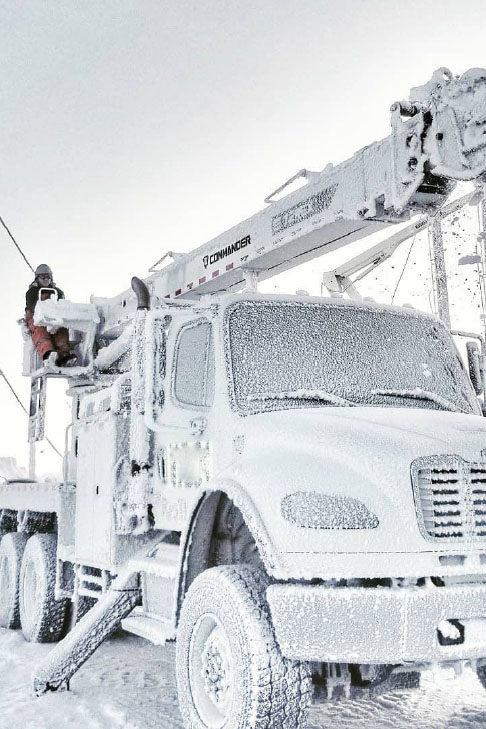Safety Minute: Setting Up Bucket Trucks and Digger Derricks in Slick Conditions

Wintertime brings bitter cold and snowy weather. When line workers must set up bucket trucks and digger derricks in snowy or icy conditions, they face additional challenges. Normal traction is greatly reduced, which could put the truck into an unstable position. Variable site locations—on gravel or grass, sloped or level—and the urgency to minimize electrical disruptions, means utility crews must often make the most of imperfect conditions.
Here are a few tips on what to do to enhance your safe work practices when setting up in slick conditions:
Remove Excess Snow and Ice
Upon arrival at the worksite, whenever possible, clear away snow and ice under outriggers and tires so that they are in contact with bare ground and avoid setting outriggers on drains or manholes.
Brush off the snow dust and ice that have accumulated during transportation from the contact surfaces, including the bottoms of outrigger feet as well as both top and bottom surfaces of the outrigger pads.
Choose a Location That Provides the Best Stability
Choose a location that provides the best stability for the work to be done. Position the truck as far onto the street or road as possible, so that if your truck does move during operation, the tires and outriggers will not slide down a slope into a ditch, manhole or other hazard. Caution is required even on pavement because gravel on concrete can act like ball bearings under outriggers and outrigger pads.
Use outrigger pads, with a textured bottom, on a level surface. Alternatively, traction aids under tires and outriggers, such as sand, gravel, or mats are also a good option.

If You’re Operating on a Sloped Surface
Operating within level tolerances is extremely important. If a slope is unavoidable, the bank of the slope may need to be cut away or cribbing should be used to level the truck. When operating the unit on a slope there is always a potential for the truck to move, even when working on dry pavement. This is due to gravity wanting to “pull” the truck down the slope.
If the sloped surface is covered with snow or ice, clean the area entirely to the dirt or pavement and use traction aids. Leveling the truck will provide more stability, especially if the unit has two sets of outriggers. Regardless, slopes are affected by gravity and the unit will want to go downhill unless there is sufficient traction. The surface the outriggers sit on must be leveled or the traction improved to prevent sliding.
Remember to Chock!
Once in position, chock the wheels to prevent movement downhill, and evaluate the chock location to make sure the truck won’t pivot around one chock.
As You Work
Once proper setup is achieved, and operation begins, it’s good practice to reduce sudden boom movements. Operate the truck by feathering the controls so that all initial and final boom movements are performed at the lowest practical speed. If a unit begins to slide during operation, the operator should stop the boom functions.
Now you know a few tips on setting up your equipment in slick conditions. Remember to keep your equipment running efficiently – if you need help with your fleet maintenance or replacement parts – don’t hesitate to contact us.

.png?sfvrsn=cfc0900d_0)